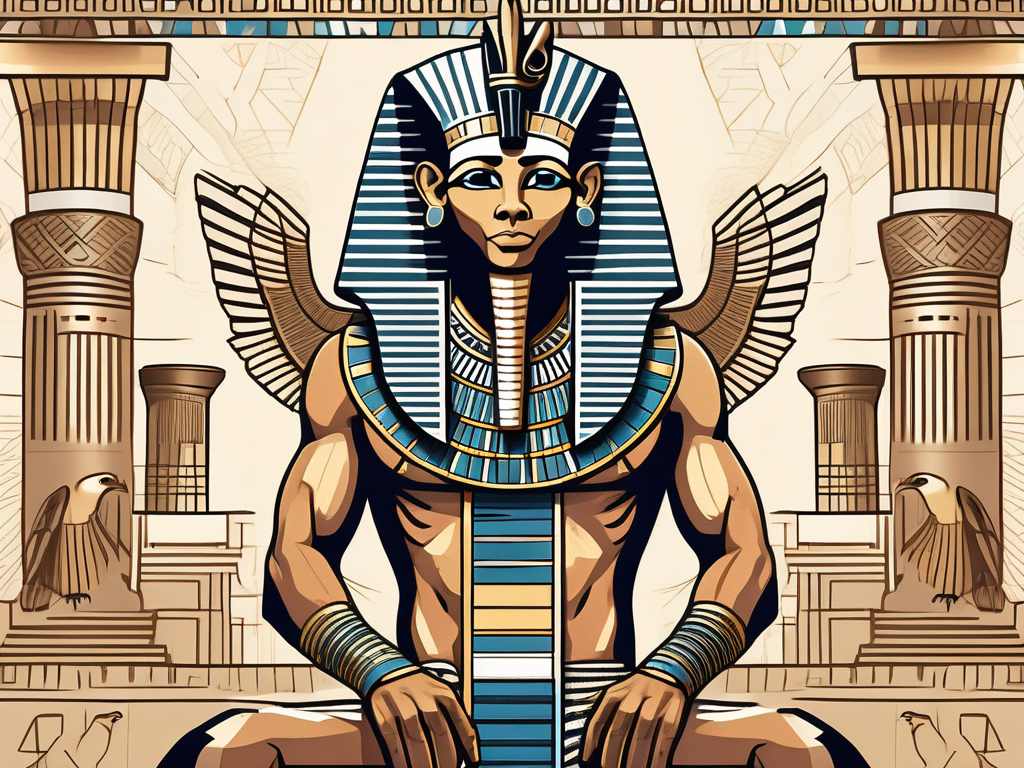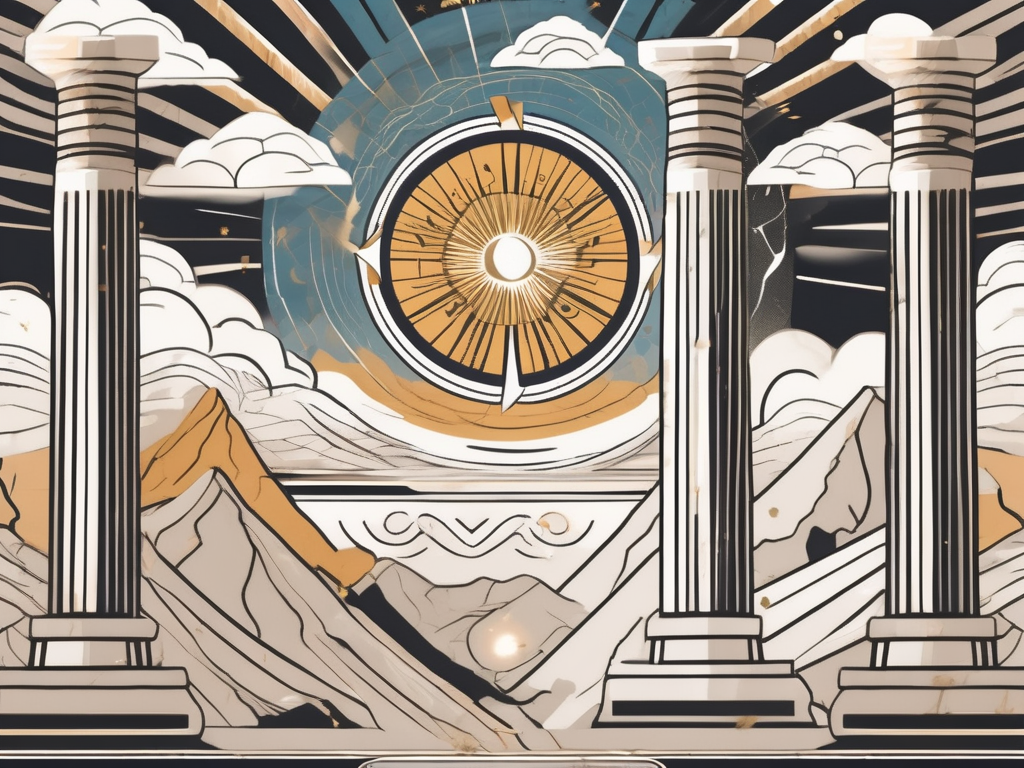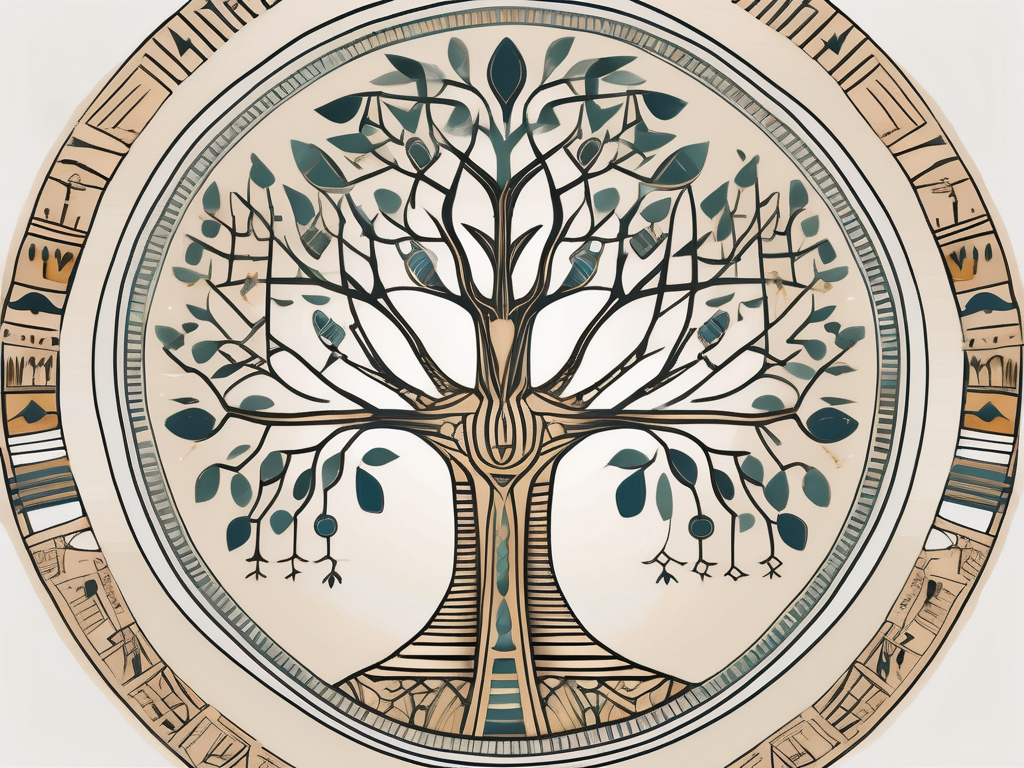Welcome to the fascinating world of Egyptian mythology, where gods and goddesses reigned supreme. In this article, we will delve into the mythical realm of the Sons of Horus, the divine offspring of the powerful Egyptian god. Buckle up and prepare for an adventurous journey as we uncover the mysteries surrounding these ancient deities.
Understanding the Myth of Horus
Before we dive into the intricacies of the Sons of Horus, let’s first explore the mythological background of Horus himself. Horus was one of the most significant gods in ancient Egyptian mythology, symbolizing kingship, sky, and protection. He was often depicted as a falcon-headed deity and was revered as the son of Osiris and Isis.
Horus, the falcon-headed god, played a pivotal role in the ancient Egyptian pantheon. As the son of Osiris and Isis, he held a special place in the hearts of the Egyptians. Known for his majestic and regal appearance, Horus embodied the qualities of a true king. His falcon form represented his ability to soar high above the mortal realm, overseeing the land of Egypt with a watchful eye.
In Egyptian mythology, Horus served as a symbol of kingship and the rightful ruler of Egypt. He was considered the protector of the pharaohs, ensuring their well-being and safeguarding their sovereignty. Horus was believed to be the divine guardian of the throne, guiding and empowering the pharaohs to rule with wisdom and justice.
The Role of Horus in Egyptian Mythology
In addition to his role as a guardian and protector, Horus played a crucial part in the cycle of life and death. He was associated with the daily cycle of the sun, representing the eternal nature of existence. Just as the sun rises and sets each day, Horus symbolized the continuous cycle of life, death, and rebirth.
As the son of Osiris, Horus also had a significant role in the myth of Osiris’ murder and resurrection. After his father’s death at the hands of Set, the god of chaos, Horus sought to avenge his father and reclaim his rightful place as the ruler of Egypt. This epic battle between Horus and Set became a central theme in Egyptian mythology, representing the eternal struggle between order and chaos.
The Symbolism of Horus in Ancient Egypt
The symbolism of Horus extended beyond his role as a protective deity. He was often depicted with the Eye of Horus, a powerful symbol associated with healing, restoration, and protection against evil. The Eye of Horus was believed to possess magical properties capable of warding off curses and bringing good fortune.
The Eye of Horus was not only a symbol of protection but also a representation of divine insight and wisdom. It was believed that Horus’ all-seeing eye could perceive hidden truths and guide mortals on their spiritual journey. The Eye of Horus was a source of comfort and reassurance for the ancient Egyptians, assuring them that they were under the watchful gaze of a benevolent and powerful deity.
Furthermore, Horus was often associated with the pharaoh’s divine legitimacy. The pharaohs were believed to be the earthly embodiment of Horus, carrying his divine essence and authority. This connection between Horus and the pharaohs reinforced the belief in the divine right to rule, establishing a strong bond between the gods and the mortal realm.
The Divine Offspring: An Overview
Now that we have a better understanding of Horus, let’s shift our focus to his divine offspring – the Sons of Horus. These four sons were believed to embody different aspects of human existence and were closely associated with the process of mummification and the afterlife.
The Sons of Horus were not only revered for their divine parentage but also for their individual characteristics and roles in ancient Egyptian mythology. Each son played a crucial role in the preservation and protection of the deceased, ensuring a successful journey into the afterlife.
The Birth and Parentage of the Sons of Horus
According to Egyptian mythology, Horus was popularly believed to have four sons: Imsety, Hapi, Duamutef, and Qebehsenuef. These sons were said to be born to Horus and the goddess Isis, who played a crucial role in their upbringing.
Imsety, the eldest son, was often depicted with a human head and represented the liver. He was associated with compassion and healing, embodying the gentle and kind-hearted nature of his divine parentage.
Hapi, portrayed with the head of a baboon, symbolized the lungs. Known for his joyful and enthusiastic nature, Hapi played a vital role in the religious ceremonies that took place during the mummification process. His presence brought a sense of celebration and reverence to the rituals.
Duamutef, with a jackal’s head, protected the stomach. As the brave and loyal protector, he guarded the deceased against evil spirits, ensuring their safety and well-being during their journey through the afterlife.
Qebehsenuef, depicted as a falcon, safeguarded the intestines. Known for his intelligence and observant nature, Qebehsenuef was responsible for protecting the canopic jars containing the organs of the deceased. His keen eye and attention to detail ensured that nothing was amiss during the mummification process.
The Individual Characteristics of Each Son
Imsety, the gentle and kind-hearted son of Horus, was associated with compassion and healing. His presence brought comfort to the deceased, offering solace and relief from any pain or suffering they may have experienced in life.
Hapi, known for his joyful and enthusiastic nature, played a vital role in the religious ceremonies that took place during the mummification process. His infectious energy and vibrant spirit uplifted the atmosphere, turning the somber rituals into moments of celebration and reverence.
Duamutef, the brave and loyal protector, guarded the deceased against evil spirits. With his jackal’s head and unwavering dedication, he stood as a formidable guardian, ensuring that no harm would befall the deceased on their journey through the afterlife.
Qebehsenuef, the intelligent and observant son, was responsible for protecting the canopic jars containing the organs of the deceased. His keen eye and meticulous attention to detail ensured that the organs were preserved and kept safe, ready to accompany the deceased in their new existence.
As the Sons of Horus, Imsety, Hapi, Duamutef, and Qebehsenuef played vital roles in the ancient Egyptian belief system. Their individual characteristics and responsibilities were deeply intertwined with the process of mummification and the afterlife, ensuring the successful transition of the deceased into the realm of eternity.
The Sons of Horus and Their Cosmic Significance
The Sons of Horus played a pivotal role in the ancient Egyptian belief system surrounding the afterlife and the journey to the great beyond.
The Sons of Horus in the Egyptian Afterlife
In Egyptian mythology, it was imperative for the deceased to have their organs preserved to ensure a successful transition to the afterlife. The Sons of Horus oversaw the preservation and protection of these organs, guiding the deceased through their perilous journey to the realm of Osiris.
As the embalmers carefully removed the organs from the deceased’s body, the Sons of Horus stood watch, their presence bringing comfort and reassurance to both the living and the dead. Imsety, with his human form, would carefully extract the liver, while Hapi, embodying the baboon, would skillfully remove the lungs. Duamutef, depicted as a jackal-headed deity, would handle the stomach, and Qebehsenuef, represented by a falcon head, would delicately extract the intestines.
These four Sons of Horus were not only responsible for the physical preservation of the organs but also played a crucial role in ensuring the spiritual well-being of the deceased. They were believed to possess divine powers that protected the organs from decay and corruption, allowing the deceased to retain their physical form in the afterlife.
Once the organs were removed, they were carefully placed in canopic jars, each guarded by one of the Sons of Horus. These jars were then buried alongside the deceased, symbolizing the eternal protection and guidance provided by the Sons of Horus on their journey to the realm of Osiris.
The Sons of Horus and Their Astronomical Associations
Interestingly, the Sons of Horus were also associated with astronomical phenomena. Imsety was connected to the north and the star Sopdet (Sirius), while Hapi was linked to the south and the star Canopus. Duamutef represented the east and was associated with the star Aldebaran, while Qebehsenuef symbolized the west and was linked to the star Antares.
These celestial associations further emphasized the cosmic significance of the Sons of Horus. Just as the stars guided travelers across the vast desert, the Sons of Horus guided the souls of the deceased through the vast expanse of the afterlife. Their connection to specific stars not only provided a celestial map for the journey but also symbolized the interconnectedness of the earthly and celestial realms.
It was believed that the alignment of these stars during specific times of the year would facilitate the safe passage of the deceased, ensuring their successful arrival in the realm of Osiris. The Sons of Horus, acting as celestial navigators, would guide the souls through the treacherous paths of the afterlife, protecting them from malevolent forces and ensuring their ultimate reunion with their divine ancestors.
These astronomical associations also reflected the Egyptian belief in the cyclical nature of life and death. Just as the stars rose and set, the souls of the deceased would embark on their journey through the afterlife, only to be reborn in the eternal cycle of existence.
The Cultural Impact of the Sons of Horus
The influence of the Sons of Horus extends far beyond ancient mythology; their presence can be felt in various aspects of Egyptian culture and art even today.
The Sons of Horus in Art and Hieroglyphs
Various ancient Egyptian artworks and hieroglyphs depict the Sons of Horus, highlighting their significance throughout the civilization’s history. Their presence can be observed in tomb paintings, temple reliefs, and even magical amulets, emphasizing their role in the religious and spiritual practices of the time.
The Sons of Horus in Modern Interpretations
The legacy of the Sons of Horus continues in the modern world, where their myths and symbols inspire artists, writers, and researchers. Their intriguing stories have sparked countless interpretations and adaptations, contributing to the ongoing fascination with ancient Egyptian culture.
Deciphering the Myth: Different Theories
Theological Interpretations of the Sons of Horus
Various scholars and theologians have put forth different theories to explain the symbolic significance of the Sons of Horus. Some suggest that the sons represent the four cardinal points, while others argue that they embody the four essential organs needed for existence.
Historical Perspectives on the Sons of Horus
From a historical standpoint, the Sons of Horus shed light on the societal values and beliefs of ancient Egyptians. Their role in the mummification process reflects the importance placed on the physical preservation of the body and the journey to the afterlife.
As we conclude our exploration of the Sons of Horus, we have witnessed the profound impact these divine offspring had on ancient Egyptian culture and spirituality. From their birth and parentage to their cosmic significance, the Sons of Horus continue to captivate our imagination and provide us with a glimpse into the mystical world of Egyptian mythology.












